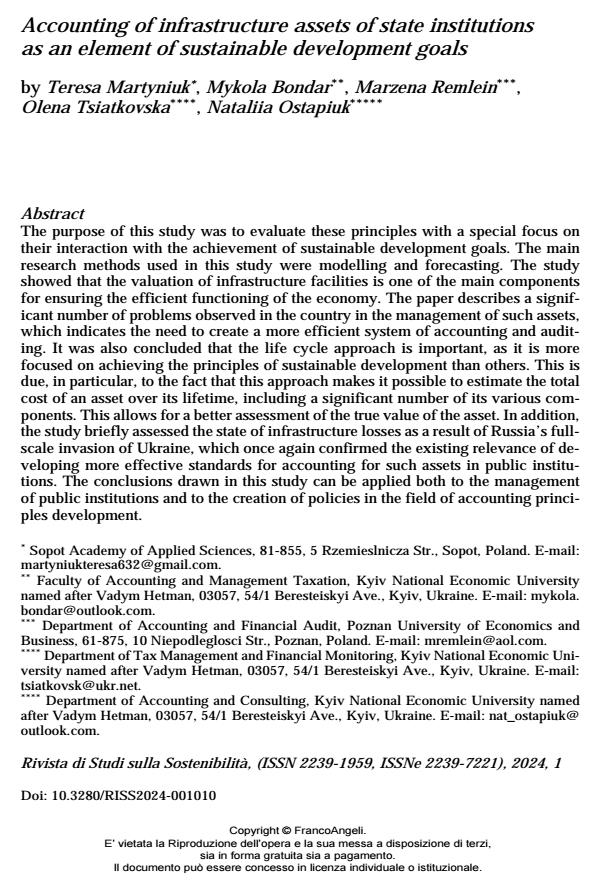Accounting of infrastructure assets of state institutions as an element of sustainable development goals
Titolo Rivista RIVISTA DI STUDI SULLA SOSTENIBILITA'
Autori/Curatori Teresa Martyniuk, Mykola Bondar, Marzena Remlein, Olena Tsiatkovska, Nataliia Ostapiuk
Anno di pubblicazione 2024 Fascicolo 2024/1
Lingua Inglese Numero pagine 15 P. 173-187 Dimensione file 310 KB
DOI 10.3280/RISS2024-001010
Il DOI è il codice a barre della proprietà intellettuale: per saperne di più
clicca qui
Qui sotto puoi vedere in anteprima la prima pagina di questo articolo.
Se questo articolo ti interessa, lo puoi acquistare (e scaricare in formato pdf) seguendo le facili indicazioni per acquistare il download credit. Acquista Download Credits per scaricare questo Articolo in formato PDF

FrancoAngeli è membro della Publishers International Linking Association, Inc (PILA)associazione indipendente e non profit per facilitare (attraverso i servizi tecnologici implementati da CrossRef.org) l’accesso degli studiosi ai contenuti digitali nelle pubblicazioni professionali e scientifiche
The purpose of this study was to evaluate these principles with a special focus on their interaction with the achievement of sustainable development goals. The main research methods used in this study were modelling and forecasting. The study showed that the valuation of infrastructure facilities is one of the main components for ensuring the efficient functioning of the economy. The paper describes a significant number of problems observed in the country in the management of such assets, which indicates the need to create a more efficient system of accounting and auditing. It was also concluded that the life cycle approach is important, as it is more focused on achieving the principles of sustainable development than others. This is due, in particular, to the fact that this approach makes it possible to estimate the total cost of an asset over its lifetime, including a significant number of its various components. This allows for a better assessment of the true value of the asset. In addition, the study briefly assessed the state of infrastructure losses as a result of Russia’s full-scale invasion of Ukraine, which once again confirmed the existing relevance of developing more effective standards for accounting for such assets in public institutions. The conclusions drawn in this study can be applied both to the management of public institutions and to the creation of policies in the field of accounting principles development.
Parole chiave:budgeting; accounting; management; fixed assets; international financial reporting standards; accounting policy.
Teresa Martyniuk, Mykola Bondar, Marzena Remlein, Olena Tsiatkovska, Nataliia Ostapiuk, Accounting of infrastructure assets of state institutions as an element of sustainable development goals in "RIVISTA DI STUDI SULLA SOSTENIBILITA'" 1/2024, pp 173-187, DOI: 10.3280/RISS2024-001010